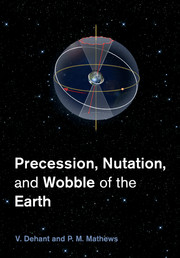Book contents
- Frontmatter
- Contents
- Preface
- List of abbreviations
- 1 Introduction – Fundamental definitions – Motivation
- 2 Concepts and elementary theory
- 3 Reference systems and frames
- 4 Observational techniques – ephemerides
- 5 Rigid Earth precession and nutation
- 6 Deformable Earth – Love numbers
- 7 Nutations of a non-rigid Earth
- 8 Anelasticity
- 9 Ocean and atmospheric corrections
- 10 Refinements of non-rigid nutation
- 11 Comparison observation-theory
- 12 Conventions
- 13 Mars nutations
- Appendix A Rotation representation
- Appendix B Clairaut theory
- Appendix C Definitions of equinoxes
- Bibliography
- Index
7 - Nutations of a non-rigid Earth
Published online by Cambridge University Press: 05 May 2015
- Frontmatter
- Contents
- Preface
- List of abbreviations
- 1 Introduction – Fundamental definitions – Motivation
- 2 Concepts and elementary theory
- 3 Reference systems and frames
- 4 Observational techniques – ephemerides
- 5 Rigid Earth precession and nutation
- 6 Deformable Earth – Love numbers
- 7 Nutations of a non-rigid Earth
- 8 Anelasticity
- 9 Ocean and atmospheric corrections
- 10 Refinements of non-rigid nutation
- 11 Comparison observation-theory
- 12 Conventions
- 13 Mars nutations
- Appendix A Rotation representation
- Appendix B Clairaut theory
- Appendix C Definitions of equinoxes
- Bibliography
- Index
Summary
The term “non-rigid Earth” has been employed in the literature to refer to any Earth model other than one that is wholly solid and rigid, and we shall follow this usage. Thus, a model consisting of a rigid mantle enclosing a fluid core (whether the fluid be compressible or not) is labeled as “non-rigid,” as is one that has no fluid region at all but is deformable. We deal in this chapter with axially symmetric ellipsoidal Earth models which are deformable, in general, and have a fluid core with or without a SIC.
Formulations of the theory for a non-rigid Earth
Most of the treatments of the nutation and precession of the non-rigid Earth have been based on one or other of two types of formulations, which are outlined below. Both have to take account of the fact that the external gravitational potentials which cause forced nutation and wobble produce also (tidal) deformations and that these deformations translate into changes in the inertia tensors of the Earth and its core regions which affect Earth rotation variations. Furthermore, rotation variations (whether forced or free) produce perturbations of the centrifugal potential associated with Earth rotation, and these centrifugal perturbations too cause deformation and an associated perturbation of the inertia tensors which, in turn, affects Earth rotation. The two formulations differ from each other in the way the interlinked phenomena of nutation/wobble and deformation are dealt with.
The simpler formulation focuses directly on the rotation variations which are governed by the equations of angular momentum conservation (often called the torque equations) for the whole Earth and for its core regions. A TRF is employed in this formulation. A simple example of this approach has been seen already in Chapter 2. The angular momenta of the Earth and its core regions involve their moments of inertia and the angular velocities of the mantle and the core regions. The moments of inertia are obtainable by integrations over the density function of the model Earth.
- Type
- Chapter
- Information
- Precession, Nutation and Wobble of the Earth , pp. 257 - 329Publisher: Cambridge University PressPrint publication year: 2015



